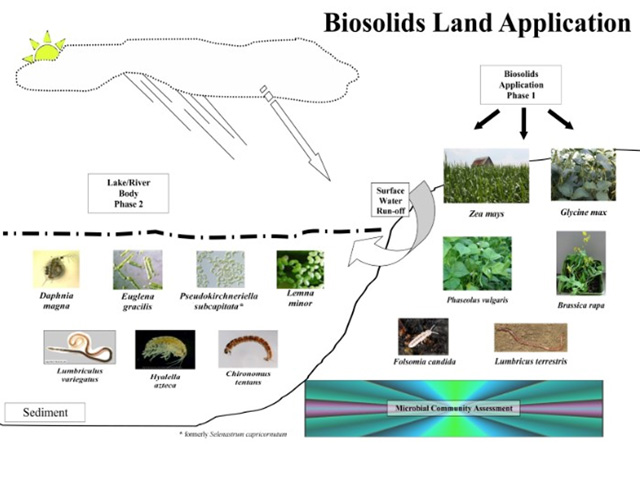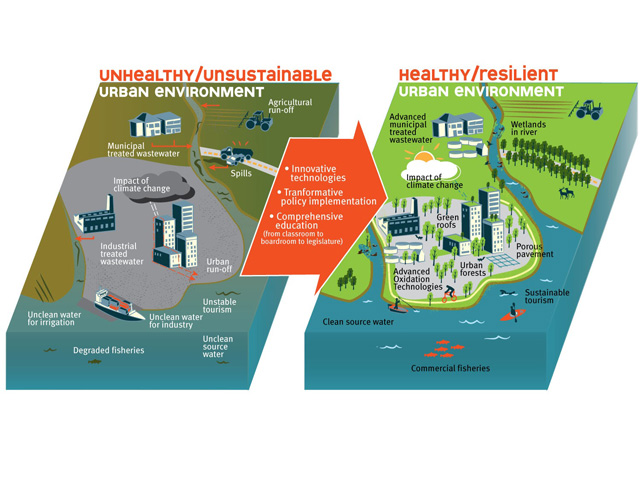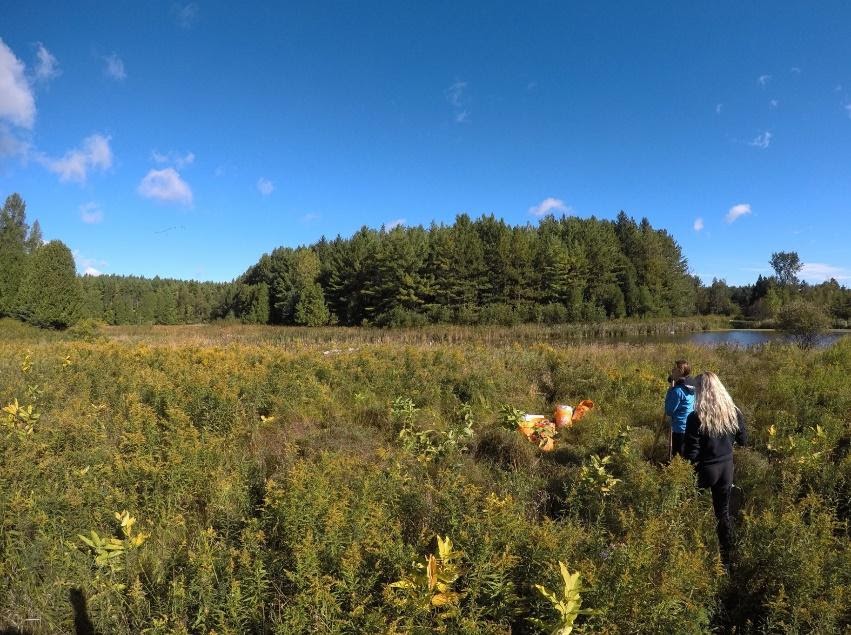Research
The McCarthy Lab specializes in aquatic ecotoxicology, specifically in assessing the impact of chemicals and other stressors on the health and behaviour of aquatic and terrestrial organisms around the Great Lakes. Another ongoing focus of Lynda’s research is examining how a sustainable and resilient urban water cycle, within the ongoing challenges of climate change, can be implemented. Lastly, rehabilitating wetlands, through the integrated knowledge of Indigenous and Western scientific scholarship, is being examined.
Research Projects


Developing real-time early-warning biomonitoring technology
This research area has addressed the need to develop an early-warning strategy to detect potential threats to organisms in the environment. A secondary application of this research was to assess challenges to drinking water supplies in Canada. The McCarthy Lab’s research studies a "miner's canary" of environmentally-relevant organisms that detects stressors commonly found in aquatic environments using ecotoxicological procedures, including multivariate tools, to develop a library of stereotyped responses from aquatic species when exposed to a group of contaminants. Alongside such strategies, collaboration in finding engineered solutions, including the use of advanced oxidation technologies to remove stressors from the environment, has been critical. ( (PDF file) Awad 2009; (PDF file) Marshall 2009; (PDF file) Pearce 2009; (PDF file) Fleet 2009; (PDF file) Labbaf 2010; (PDF file) Dort 2010; (PDF file) Doobay 2011; (PDF file) Raby 2013; (PDF file) McNamee 2020).
The development of a miner’s canary has led to other research endeavours.
Research objectives:
- Use multivariate tools to develop a library of stereotyped responses from aquatic species when exposed to a group of contaminants
- Develop engineered solutions using advanced oxidation technologies to remove stressors from the environment

Although engineered land-application of biosolids in agriculture has gained momentum in recent years, there remains insufficient data on the impact of biosolids runoff to surrounding waters. The McCarthy Lab’s research has been the first of its kind to address these issues using environmentally-relevant food chain components and engineered wetlands to assess, capture, and control biosolid runoff. The team’s research lives both within a laboratory and field context and has used biosolids from industrial sources (pulp and paper mills) and municipal biosolids from sewage treatment plants from across Canada. ( (PDF file) Gebert 2010; (PDF file) Puddephatt 2013)
Researchers from Trent University, University of Guelph, and University of Waterloo, the Cities of Calgary, Halifax, and Toronto, Halton Region, the Ministry of Agriculture, Food and Rural Affairs (OMAFRA), and the Ministry of then Environment and Climate Change (MOECC), Environment Canada, and several industries have been involved.

The Great Lakes are the primary source of water for 13 million people living in Ontario, with most residing in major urban centres such as Toronto. Healthy vigorous cities need healthy, sustainable water management strategies and policies. However, current, reactionary approaches to water management has us mired in unhealthy and unsustainable urban water cycles.
The McCarthy lab is interested in studying how to transform an “unhealthy/unsustainable urban environment” into a “healthy/resilient urban environment” by examining:
- protecting source water through the transformation of urban spaces into healthy built environments
- maintaining quality source water by multi-monitoring strategies
Concurrently, evidence-based knowledge generation from these two themes will enable transformative policy implementation. This, along with better public education, can move us to healthy, resilient water cycles without sacrificing economic assets in the watershed.
Image Credit: Artist Kai, Faculty of Science, 2013

The importance of wetlands cannot be over-emphasized, as their biological diversity makes them one of the most ecologically-relevant habitats in the world. However, profligate destruction of these vital environments around the Great Lakes has taken place over the past several decades and strategies to rehabilitate these invaluable biomes is being implemented. In the McCarthy Lab, research has been ongoing to examine how engineered, or constructed, wetlands can be used to mitigate the impact of contaminant runoff during extreme weather events from agricultural fields and roadways. Contaminants can include excessive phosphorous, polyaromatic hydrocarbons, heavy metals (ie. Ni, Cu, Zn, Cd, and Pb), pesticides, road salt, and sediment. The lab’s first attempts at improving shorelines found that most macrophytes being used in constructed wetlands were invasive species such as Typha latifolia that destroy native biodiversity ( (PDF file) Tiley 2013). In an effort to establish greater variability in plant species, (PDF file) Fernandes (2017) evaluated macrophyte selection and germination protocols to enhance nutrient sequestration in engineered wetland models. (PDF file) Tucci (2021) attempted to simulate a natural Southern Ontario wetland by creating a native, non-invasive engineered system in the laboratory and currently, research in rehabilitating wetlands through the integrated knowledge of Indigenous and Western scientific scholarship is being conducted.
Image Credit: S. Alkins; 2018
Selection of Past Student Theses

| Name | Degree | Title | Supervisors |
|---|---|---|---|
| Morrigan Everatt | MSc | Incorporating Indigenous scientific knowledge alongside Western environmental strategies in the rehabilitation of native wetlands. | Lynda McCarthy, Andrew Laursen |
| Christian Garcia | MSc | The effect of greywater irrigation on selected terrestrial organisms: Brassica rapa, Lumbricus terrestris, Folsomia candida. | Lynda McCarthy, Mehrab Mehrvar |
| Paul Stecko | MSc | The effects of strong and weak electromagnetic fields at extremely low frequencies on Lemna minor and Hyalella azteca. | Andrew Laursen, Lynda McCarthy |
| Christopher Taghizadeh | MSc | Why are drinking water advisories still in place? A case study analysis comparing Indigenous and non-Indigenous communities. | Lynda McCarthy, Andrew Laursen |
| Nate Clark | PhD | Silver-stabilized hydrogen peroxide for Legionella control in hot water systems. | Steven Liss, Lynda McCarthy |
| Maryam Moradi | PhD | Characterization of alkylated polycyclic aromatic hydrocarbons in urban and industrial settings. | James Li, Lynda McCarthy |
| Name | Degree | Title | Year | |
|---|---|---|---|---|
| Joanna Tucci |
MSc |
Phytoremediation of terrestrial contaminant runoff using native macrophytes in engineered wetlands. |
2021 |
|
| Rachel McNamee |
MSc |
Assessing acute, chronic, and reproductive impact of polyethylene microplastics on Daphnia magna and Hyalella azteca. |
2020 |
|
| Amanda Jacqueline Morris |
PhD (co-supervisor) |
Detection and genotyping of Cryptosporidium spp. in biofilms and cattle feces from the Black River watershed, Jamaica. |
2019 |
|
| Michelle Lucas |
MSc |
Field-based assessment of the influence of agriculture and urbanization on benthic macroinvertebrates in southern Ontario and laboratory-based assessment of the toxicity of road salt to biofilms. |
2018 |
|
| Francesca Mary Fernandes |
MSc |
Evaluating macrophyte selection and germination protocols to enhance nutrient sequestration in engineered wetland models. |
2017 |
|
| Karen Joan Puddephatt |
MSc |
Determining the sustainability of land-applying biosolids to agricultural lands using environmentally-relevant Terrestrial Biota. |
2013 |
|
| Melanie Raby | MSc | Toxicity assessment of the antimicrobial Triclocarban using sub-lethal behaviour and reproduction endpoints of Daphnia magna and Hyalella azteca. | 2013 | |
| Mark Henry Tiley | MSc | Typha latifolia response to oligotrophic and eutrophic nitrogen and phosphorus loading rates under laboratory conditions. | 2013 | |
| Sean Doobay | The utilization of the freshwater invertebrates Hyalella azteca and Daphnia magna for use in assessing potential endocrine distruption in aquatic systems. | 2011 | ||
| Sonja Gebert | MSc | Assessing ecological impacts of land‐applied municipal biosolids: effects of run‐off and tile drainage on the aquatic organisms Daphnia magna, Hyalella azteca, and Lemna minor. | 2010 | |
| Andrea Dort | The application of an early‐warning biomonitoring system (EWBS) in a Canadian context. | 2010 | ||
| Zahra Labbaf | Identifying the potential sources of contaminants to the Welland Canal, The major source of drinking water In the Niagara Region. | 2010 | ||
| Vivien Fleet | Use of the multispecies freshwater biomonitor to determine behavioural effects of Tributyltin and Atrazine on Daphnia magna and Hyalella azteca. | 2010 | ||
| Christopher J.E. Pearce | Investigating the sub-acute responses of Lemna minor, Pseudokirchneriella subcapitata, Euglena gracilis and Anodonta grandis to tributyltin-hydride and altrazine in freshwater. | 2009 | ||
| Emily Rachel Awad | Toxicity and bioaccumulation of 2,2', 4,4'-tetrabromodiphenyl ether (BDE47) in a laboratory aquatic food chain. | 2009 | ||
| Gillian Claire Marshall | Assessing behavioural and physiological responses of three aquatic invertebrates to tributyltin and atrazine in a multi-series, early warning biomonitoring technology. | 2009 |